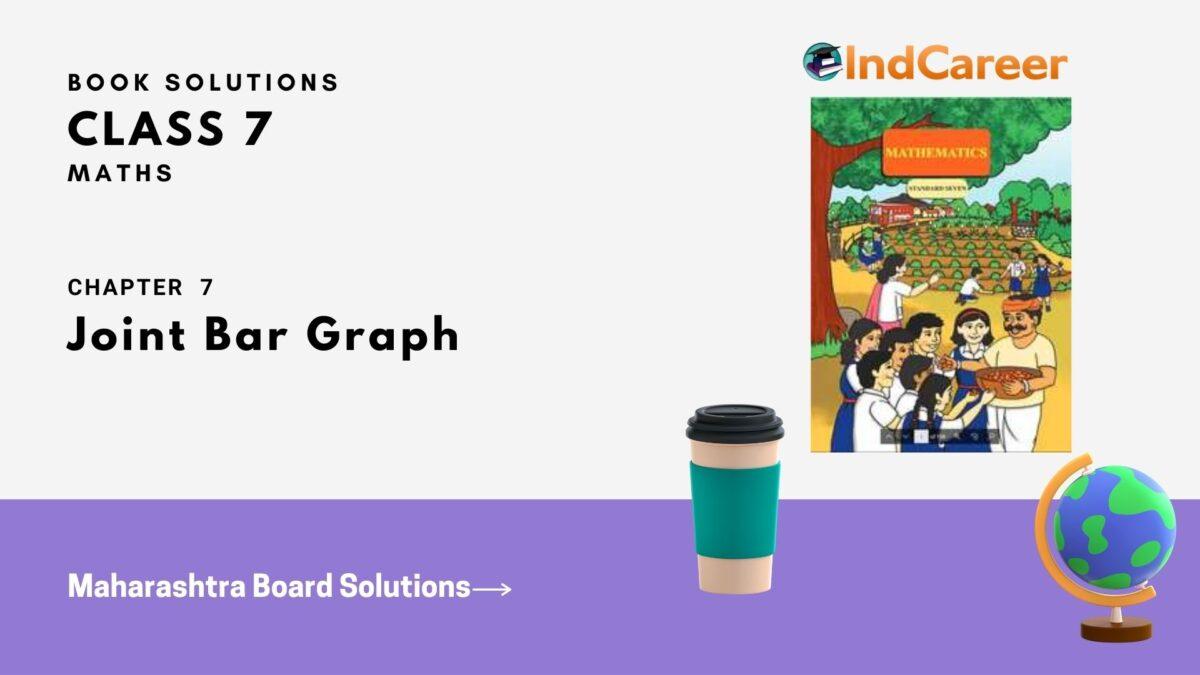Class 7: Maths Chapter 7 solutions. Complete Class 7 Maths Chapter 7 Notes.
Contents
Maharashtra Board Solutions Class 7-Maths (Practice Set 31): Chapter 7- Joint Bar Graph
Maharashtra Board 7th Maths Chapter 7, Class 7 Maths Chapter 7 solutions
Question 1.
The number of saplings planted by schools on World Tree Day is given in the table below. Draw a joint bar graph to show these figures.
| School Name\Name of Sapling | Almond | Karanj | Neem | Ashok | Gulmohar |
| Nutan Vidyalaya | 40 | 60 | 72 | 15 | 42 |
| Bharat Vidyalaya | 42 | 38 | 60 | 25 | 40 |
Solution:
Question 2.
The table below shows the number of people who had the different juices at a juice bar on a Saturday and a Sunday. Draw a joint bar graph for this data.
| Days\Fruits | Sweet Lime | Orange | Apple | Pineapple |
| Saturday | 43 | 30 | 56 | 40 |
| Sunday | 59 | 65 | 78 | 67 |
Solution:
Question 3.
The following numbers of votes were cast at 5 polling booths during the Gram Panchayat elections. Draw a joint bar graph for this data.
| Persons\Booth No. | 1 | 2 | 3 | 4 | 5 |
| Men | 200 | 270 | 560 | 820 | 850 |
| Women | 700 | 240 | 340 | 640 | 470 |
Solution:
Question 4.
The maximum and minimum temperatures of five Indian cities are given in °C. Draw a joint bar graph for this data.
| City\Temperature | Delhi | Mumbai | Kolkata | Nagpur | Kapurthala |
| Maximum temperature | 35 | 32 | 37 | 41 | 37 |
| Minimum temperature | 26 | 25 | 26 | 29 | 26 |
Solution: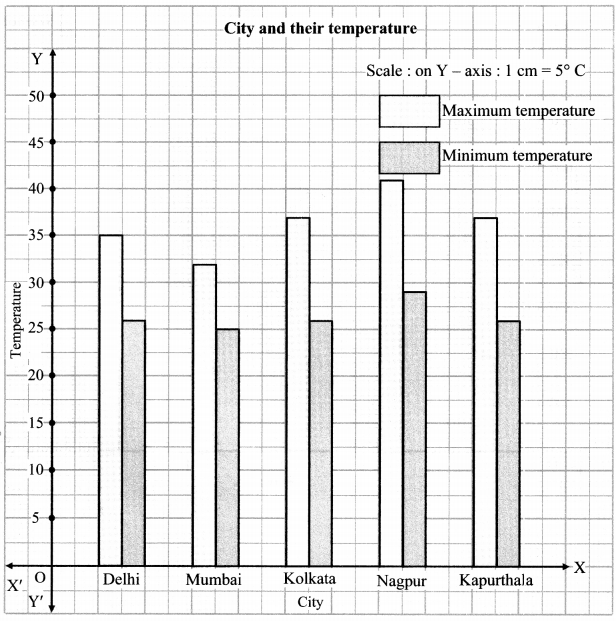
Question 5.
The numbers of children vaccinated in one day at the government hospitals in Solapur and Pune are given in the table. Draw a joint bar graph for this data:
| City\Vaccine | D.P.T. (Booster) | Polio (Booster) | Measles | Hepatitis |
| Solapur | 65 | 60 | 65 | 63 |
| Pune | 89 | 87 | 88 | 86 |
Solution: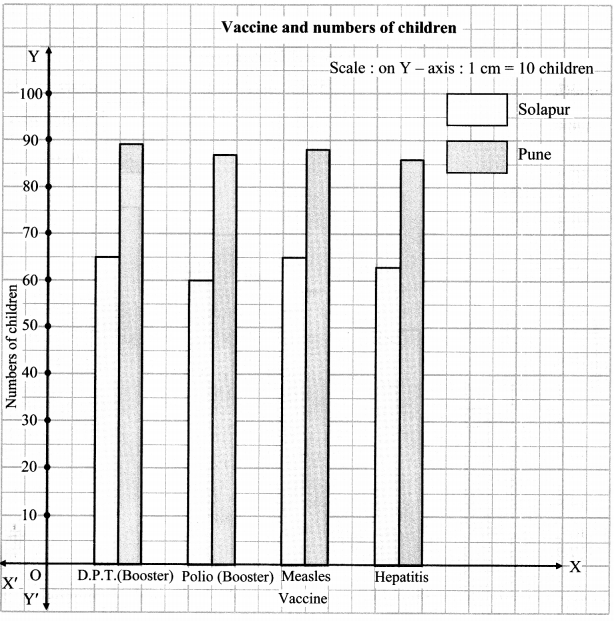
Question 6.
The percentage of literate people in the states of Maharashtra and Gujarat are given below. Draw a joint bar graph for this data.
| State\Year | 1971 | 1981 | 1991 | 2001 | 2011 |
| Maharashtra | 46 | 57 | 65 | 77 | 83 |
| Gujarat | 40 | 45 | 61 | 69 | 79 |
Solution:
Intext Questions and Activities
Question 1.
Observe the graph shown below and answer the following questions. (Textbook pg. no. 51)
- In which year did Ajay and Vijay both produce equal quantities of wheat?
- In year 2014, who produced more wheat?
- In year 2013, how much wheat did Ajay and Vijay each produce?

Solution:
- Both produced equal quantities of wheat in the year 2011.
- Ajay produced more wheat in the year 2014.
- Ajay’s wheat production in 2013 = 40 quintal.
Vijay’s wheat production in 2013 = 30 quintal.
Question 2.
The minimum and maximum temperature in Pune for five days is given. Read the joint bar graph and answer the questions below: (Textbook pg. no. 52)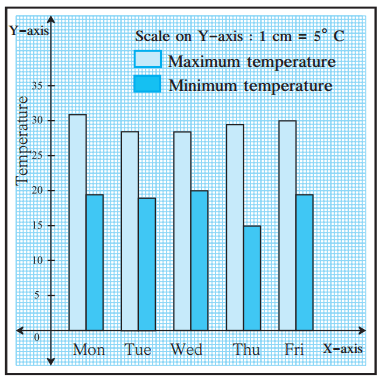
- What data is shown on X- axis?
- What data is shown on Y- axis?
- Which day had the highest temperature?
- On which day is the minimum temperature the highest?
- On Thursday, what is the difference between the minimum and maximum temperature?
- On which day is the difference between the minimum and maximum temperature the greatest?
Solution:
- Five days of a week are shown on X – axis.
- Temperature in the city of Pune is shown on Y – axis.
- Monday had the highest temperature.
- The minimum temperature was highest on Wednesday.
- Maximum temperature = 29.5° C
Minimum temperature = 15° C
∴ Difference in temperature = 29.5° C – 15° C = 14.5 ° C - The difference in minimum and maximum temperature is greatest on Thursday.
Question 3.
Collect various kinds of graphs from newspapers and discuss them. (Textbook pg. no. 53)
i. Histogram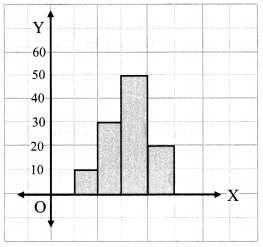
ii. Line graph
iii. Pie chart
Solution:
(Students should attempt the above activities on their own.)
Download PDF
Maharashtra Board Solutions Class 7-Maths (Practice Set 31): Chapter 7- Joint Bar Graph
Chapterwise Maharashtra Board Solutions Class 7 Maths :
- Chapter 1- Geometrical Constructions (Practice Set 1)
- Chapter 1- Geometrical Constructions (Practice Set 2)
- Chapter 1- Geometrical Constructions (Practice Set 3)
- Chapter 1- Geometrical Constructions (Practice Set 4)
- Chapter 1- Geometrical Constructions (Practice Set 5)
- Chapter 1- Geometrical Constructions (Practice Set 6)
- Chapter 1- Geometrical Constructions (Practice Set 7)
- Chapter 2- Multiplication and Division of Integers (Practice Set 8)
- Chapter 2- Multiplication and Division of Integers (Practice Set 9)
- Chapter 3- HCF and LCM (Practice Set 10)
- Chapter 3- HCF and LCM (Practice Set 11)
- Chapter 3- HCF and LCM (Practice Set 12)
- Chapter 3- HCF and LCM (Practice Set 13)
- Chapter 3- HCF and LCM (Practice Set 14)
- Chapter 4- Angles and Pairs of Angles (Practice Set 15)
- Chapter 4- Angles and Pairs of Angles (Practice Set 16)
- Chapter 4- Angles and Pairs of Angles (Practice Set 17)
- Chapter 4- Angles and Pairs of Angles (Practice Set 18)
- Chapter 4- Angles and Pairs of Angles (Practice Set 19)
- Chapter 4- Angles and Pairs of Angles (Practice Set 20)
- Chapter 4- Angles and Pairs of Angles (Practice Set 21)
- Chapter 5- Operations on Rational Numbers (Practice Set 22)
- Chapter 5- Operations on Rational Numbers (Practice Set 23)
- Chapter 5- Operations on Rational Numbers (Practice Set 24)
- Chapter 5- Operations on Rational Numbers (Practice Set 25)
- Chapter 6- Indices (Practice Set 26)
- Chapter 6- Indices (Practice Set 27)
- Chapter 6- Indices (Practice Set 28)
- Chapter 6- Indices (Practice Set 29)
- Chapter 6- Indices (Practice Set 30)
- Chapter 7- Joint Bar Graph (Practice Set 31)
- Chapter 8- Algebraic Expressions and Operations on them (Practice Set 32)
- Chapter 8- Algebraic Expressions and Operations on them (Practice Set 33)
- Chapter 8- Algebraic Expressions and Operations on them (Practice Set 34)
- Chapter 8- Algebraic Expressions and Operations on them (Practice Set 35)
- Chapter 8- Algebraic Expressions and Operations on them (Practice Set 36)
- Chapter 9- Direct Proportion and Inverse Proportion (Practice Set 37)
- Chapter 9- Direct Proportion and Inverse Proportion (Practice Set 38)
- Chapter 9- Direct Proportion and Inverse Proportion (Practice Set 39)
- Chapter 10- Bank and Simple Interest (Practice Set 40)
- Chapter 10- Bank and Simple Interest (Practice Set 41)
- Chapter 11- Circle (Practice Set 42)
- Chapter 11- Circle (Practice Set 43)
- Chapter 12- Perimeter and Area (Practice Set 44)
- Chapter 12- Perimeter and Area (Practice Set 45)
- Chapter 12- Perimeter and Area (Practice Set 46)
- Chapter 12- Perimeter and Area (Practice Set 47)
- Chapter 13- Pythagoras Theorem (Practice Set 48)
- Chapter 13- Pythagoras Theorem (Practice Set 49)
- Chapter 14- Algebraic Formulae – Expansion of Squares (Practice Set 50)
- Chapter 14- Algebraic Formulae – Expansion of Squares (Practice Set 51)
- Chapter 14- Algebraic Formulae – Expansion of Squares (Practice Set 52)
- Chapter 14- Algebraic Formulae – Expansion of Squares (Practice Set 53)
- Chapter 15- Statistics (Practice Set 54)
- Chapter 14- Statistics (Practice Set 55)
FAQs
You can download the Maharashtra State Board Books from the eBalbharti official website, i.e. cart.ebalbharati.in or from this article.
Students can get the Maharashtra Books for primary, secondary, and senior secondary classes from here. You can view or download the Maharashtra State Board Books from this page or from the official website for free of cost. Students can follow the detailed steps below to visit the official website and download the e-books for all subjects or a specific subject in different mediums.
Step 1: Visit the official website ebalbharati.in
Step 2: On the top of the screen, select “Download PDF textbooks”
Step 3: From the “Classes” section, select your class.
Step 4: From “Medium”, select the medium suitable to you.
Step 5: All Maharashtra board books for your class will now be displayed on the right side.
Step 6: Click on the “Download” option to download the PDF book.
As of now, the MSCERT and Balbharti are responsible for the syllabus and textbooks of Classes 1 to 8, while Classes 9 and 10 are under the Maharashtra State Board of Secondary and Higher Secondary Education (MSBSHSE).
The Maharashtra State Board of Secondary & Higher Secondary Education, conducts the HSC and SSC Examinations in the state of Maharashtra through its nine Divisional Boards located at Pune, Mumbai, Aurangabad, Nasik, Kolhapur, Amravati, Latur, Nagpur and Ratnagiri.
About Maharashtra State Board (MSBSHSE)
The Maharashtra State Board of Secondary and Higher Secondary Education or MSBSHSE (Marathi: महाराष्ट्र राज्य माध्यमिक आणि उच्च माध्यमिक शिक्षण मंडळ), is an autonomous and statutory body established in 1965. The board was amended in the year 1977 under the provisions of the Maharashtra Act No. 41 of 1965.
The Maharashtra State Board of Secondary & Higher Secondary Education (MSBSHSE), Pune is an independent body of the Maharashtra Government. There are more than 1.4 million students that appear in the examination every year. The Maha State Board conducts the board examination twice a year. This board conducts the examination for SSC and HSC.
The Maharashtra government established the Maharashtra State Bureau of Textbook Production and Curriculum Research, also commonly referred to as Ebalbharati, in 1967 to take up the responsibility of providing quality textbooks to students from all classes studying under the Maharashtra State Board. MSBHSE prepares and updates the curriculum to provide holistic development for students. It is designed to tackle the difficulty in understanding the concepts with simple language with simple illustrations. Every year around 10 lakh students are enrolled in schools that are affiliated with the Maharashtra State Board.
